Magadha: Difference between revisions
Tags: Mobile edit Mobile web edit |
adding info |
||
| Line 47: | Line 47: | ||
| HDI_year = |
| HDI_year = |
||
}} |
}} |
||
'''Magadha''' was an ancient Indian kingdom in the southern part of the Indian state [[Bihar]] (before expansion), and was counted as one of the sixteen {{lang-sa|script=Latn|[[Mahajanapada]]s|label=none|lit=Great Kingdoms}} of ancient India. Magadha played an important role in the development of [[Jainism]] and [[Buddhism]], and |
'''Magadha''' was an ancient Indian kingdom in the southern part of the Indian state [[Bihar]] (before expansion), and was counted as one of the sixteen {{lang-sa|script=Latn|[[Mahajanapada]]s|label=none|lit=Great Kingdoms}} of ancient India. Magadha played an important role in the development of [[Jainism]] and [[Buddhism]], and three of India's greatest empires, the [[Nanda Empire]], [[Maurya Empire]] and [[Gupta Empire]], originated in Magadha. |
||
The [[Maurya Empire|Mauryan Empire]] and [[Gupta Empire]], both of which originated in Magadha, saw advancements in ancient India's science, [[Indian mathematics|mathematics]], [[astronomy]], religion, and [[Indian philosophy|philosophy]] and were considered the Golden Age of India. Villages had their own assemblies under their local chiefs called Gramakas. Their administrations were divided into executive, judicial, and military functions. |
The [[Maurya Empire|Mauryan Empire]] and [[Gupta Empire]], both of which originated in Magadha, saw advancements in ancient India's science, [[Indian mathematics|mathematics]], [[astronomy]], religion, and [[Indian philosophy|philosophy]] and were considered the Golden Age of India. Villages had their own assemblies under their local chiefs called Gramakas. Their administrations were divided into executive, judicial, and military functions. |
||
Revision as of 17:11, 15 July 2021
This article has multiple issues. Please help improve it or discuss these issues on the talk page. (Learn how and when to remove these template messages)
|
Kingdom of Magadha | |||||||||
|---|---|---|---|---|---|---|---|---|---|
 Magadha and other Mahajanapadas in the post-Vedic period | |||||||||
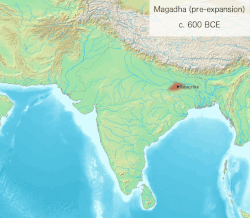 Territorial expansion of the Magadha empires 6th century BCE onwards | |||||||||
| Capital | Rajagriha (Girivraj) Later, Pataliputra (modern-day Patna) | ||||||||
| Common languages | Sanskrit, Prakrit | ||||||||
| Religion | Hinduism Buddhism Jainism | ||||||||
| Government | Absolute monarchy as described in the Arthashastra | ||||||||
| Samraat (Emperor) | |||||||||
• c. 544 - c. 492 BCE | Bimbisara | ||||||||
• c. 492 - c. 460 BCE | Ajatashatru | ||||||||
• c. 460 - c. 444 BCE | Udayin | ||||||||
• c. 437 - c. 413 BCE | Nāgadāsaka | ||||||||
• c. 413 - c. 395 BCE | Shishunaga | ||||||||
• c. 395 - c. 367 BCE | Kalashoka | ||||||||
| Historical era | Antiquity | ||||||||
| Currency | Panas | ||||||||
| |||||||||
| Today part of | India Bangladesh Nepal[citation needed] | ||||||||
Magadha was an ancient Indian kingdom in the southern part of the Indian state Bihar (before expansion), and was counted as one of the sixteen Mahajanapadas, 'Great Kingdoms' of ancient India. Magadha played an important role in the development of Jainism and Buddhism, and three of India's greatest empires, the Nanda Empire, Maurya Empire and Gupta Empire, originated in Magadha.
The Mauryan Empire and Gupta Empire, both of which originated in Magadha, saw advancements in ancient India's science, mathematics, astronomy, religion, and philosophy and were considered the Golden Age of India. Villages had their own assemblies under their local chiefs called Gramakas. Their administrations were divided into executive, judicial, and military functions.
Geography
The kingdom of the Magadha, before its expansion, corresponded to the modern districts of Patna, Jehanabad, Nalanda, Aurangabad, Arwal, Nawada and Gaya in southern Bihar. It was bounded on the north by the river Ganges, on the east by the river Champa, on the south by the Chota Nagpur Plateau, and on the west by the Son River.
This region of Greater Magadha had a culture and belief system of its own that predated Hinduism. Much of the second urbanisation took place here from c. 500 BCE onwards and it was here that Jainism became strong and Buddhism arose. The importance of Magadha's culture can be seen in that Buddhism, Jainism and Hinduism adopted some of its features, most significantly a belief in rebirth and karmic retribution.[1]
History



Some scholars have identified the Kīkaṭa tribe—mentioned in the Rigveda (3.53.14) with their ruler Pramaganda—as the forefathers of Magadhas because Kikata is used as synonym for Magadha in the later texts;[2] Like the Magadhas in the Atharvaveda, the Rigveda speaks of the Kikatas as a hostile tribe, living on the borders of Brahmanical India, who did not perform Vedic rituals.[3]
The earliest reference to the Magadha people occurs in the Atharvaveda, where they are found listed along with the Angas, Gandharis and Mujavats. The core of the kingdom was the area of Bihar south of the Ganges; its first capital was Rajagriha (modern day Rajgir), then Pataliputra (modern Patna). Rajagriha was initially known as 'Girivrijja' and later came to be known as so during the reign of Ajatashatru. Magadha expanded to include most of Bihar and Bengal with the conquest of Vajji confederation and Anga, respectively.[4] The kingdom of Magadha eventually came to encompass Bihar, Jharkhand, Orissa, West Bengal, eastern Uttar Pradesh, and the areas that are today the nations of Bangladesh and Nepal.[5]
The ancient kingdom of Magadha is heavily mentioned in Jain and Buddhist texts. It is also mentioned in the Ramayana, the Mahabharata and the Puranas.
There is little certain information available on the early rulers of Magadha. The most important sources are the Buddhist Pāli Canon, the Jain Agamas and the Hindu Puranas. Based on these sources, it appears that Magadha was ruled by the Haryanka dynasty for some 200 years, c. 543 to 413 BCE.[citation needed]
Gautama Buddha, the founder of Buddhism, lived much of his life in the kingdom of Magadha. He attained enlightenment in Bodh Gaya, gave his first sermon in Sarnath and the first Buddhist council was held in Rajgriha.[6]
The Hindu Mahabharata calls Brihadratha the first ruler of Magadha. King Bimbisara of the Haryanka dynasty led an active and expansive policy, conquering the Kingdom of Anga in what is now West Bengal. King Bimbisara was killed by his son, Prince Ajatashatru. King Pasenadi, king of neighbouring Kosala and brother-in-law of King Bimbisara, promptly retook the gift of the Kashi province.
Accounts differ slightly as to the cause of King Ajatashatru's war with the Licchavi, an area north of the river Ganges. It appears that Ajatashatru sent a minister to the area who worked for three years to undermine the unity of the Licchavis. To launch his attack across the Ganges River, Ajatashatru built a fort at the town of Pataliputra. Torn by disagreements, the Licchavis fought with Ajatashatru. It took fifteen years for Ajatashatru to defeat them. Jain texts tell how Ajatashatru used two new weapons: a catapult, and a covered chariot with swinging mace that has been compared to a modern tank. Pataliputra began to grow as a centre of commerce and became the capital of Magadha after Ajatashatru's death.
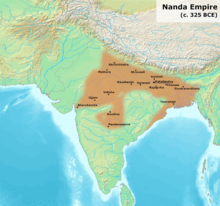
The Haryanka dynasty was overthrown by the Shishunaga dynasty. The last Shishunaga ruler, Mahanandin, was assassinated by Mahapadma Nanda in 345 BCE, the first of the so-called "Nine Nandas", i. e. Mahapadma and his eight sons.
In 326 BCE, the army of Alexander approached the western boundaries of Magadha. The army, exhausted and frightened at the prospect of facing another giant Indian army at the Ganges, mutinied at the Hyphasis (the modern Beas River) and refused to march further east. Alexander, after the meeting with his officer Coenus, was persuaded that it was better to return and turned south, conquering his way down the Indus to the Ocean.


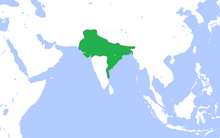
| History of South Asia |
|---|
 |
Around 321 BCE, the Nanda Dynasty ended and Chandragupta Maurya became the first king of the great Mauryan dynasty and Mauryan Empire with the help of Chanakya. The Empire later extended over most of South Asia under King Ashoka, who was at first known as 'Ashoka the Cruel' but later became a disciple of Buddhism and became known as 'Dharma Ashoka'.[7][8] Later, the Mauryan Empire ended, as did the Shunga and Khārabēḷa empires, to be replaced by the Gupta Empire. The capital of the Gupta Empire remained Pataliputra in Magadha.
Culture
Several Śramaṇic movements have existed before the 6th century BCE, and these influenced both the āstika and nāstika traditions of Indian philosophy.[9] The Śramaṇa movement gave rise to diverse range of heterodox beliefs, ranging from accepting or denying the concept of soul, atomism, antinomian ethics, materialism, atheism, agnosticism, fatalism to free will, idealization of extreme asceticism to that of family life, strict ahimsa (non-violence) and vegetarianism to permissibility of violence and meat-eating.[10] Magadha kingdom was the nerve centre of this revolution.
Jainism was revived and re-established after Mahavira, the last and the 24th Tirthankara, synthesised and revived the philosophies and promulgations of the ancient Śramaṇic traditions laid down by the first Jain tirthankara Rishabhanatha millions of years ago.[11]Buddha founded Buddhism which received royal patronage in the kingdom.
According to Indologist Johannes Bronkhorst, the culture of Magadha was in fundamental ways different from the Vedic kingdoms of the Indo-Aryans. He argues for a cultural area termed "Greater Magadha", defined as roughly the geographical area in which the Buddha and Mahavira lived and taught.[1] Suggestive of this distinction, in some Vedic and post-Vedic rituals, a "Magadha man" represents the canonical non-Vedic "Barbarian", the Magadhan standing in for the presence of any and all non-Vedic peoples or the ritually impure.[12]


With regard to the Buddha, this area stretched by and large from Śrāvastī, the capital of Kosala, in the north-west to Rājagṛha, the capital of Magadha, in the south-east".[13] According to Bronkhorst “there was indeed a culture of Greater Magadha which remained recognizably distinct from Vedic culture until the time of the grammarian Patañjali (ca. 150 BCE) and beyond”.[14] Vedic texts such as the Satapatha Brahmana demonize the inhabitants of this area as demonic and as speaking a barbarous speech. The Buddhologist Alexander Wynne writes that there is an "overwhelming amount of evidence" to suggest that this rival culture to the Vedic Aryans dominated the eastern Gangetic plain during the early Buddhist period. Orthodox Vedic Brahmins were, therefore, a minority in Magadha during this early period.[15]
The Magadhan religions are termed the sramana traditions and include Jainism, Buddhism and Ājīvika. Buddhism and Jainism were the religions promoted by the early Magadhan kings, such as Srenika, Bimbisara and Ajatashatru, and the Nanda Dynasty (345–321 BCE) that followed was mostly Jain. These Sramana religions did not worship the Vedic deities, practised some form of asceticism and meditation (jhana) and tended to construct round burial mounds (called stupas in Buddhism).[14] These religions also sought some type of liberation from the cyclic rounds of rebirth and karmic retribution through spiritual knowledge.
List of dynasties & Rulers
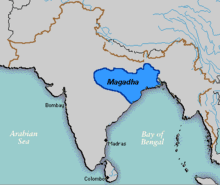
This list includes the legendary kings of Magadha:
Brihadratha (Rawani) dynasty (c. 1700 – 682 BCE)
(founder of Brihadratha dynasty)
(Greatest King of Brihadratha dynasty)
(son of Jarasandha)
- Somadhi (1661–1603 BCE)
- Srutasravas (1603–1539 BCE)
- Ayutayus (1539–1503 BCE)
- Niramitra (1503–1463 BCE)
- Sukshatra (1463–1405 BCE)
- Brihatkarman ( 1405–1382 BCE)
- Senajit ( 1382–1332 BCE)
- Srutanjaya ( 1332–1292 BCE)
- Vipra (1292–1257 BCE)
- Suchi (1257–1199 BCE)
- Kshemya (1199–1171 BCE)
- Subrata (1171–1107BCE)
- Dharma ( 1107–1043 BCE)
- Susuma (1008–970 BCE)
- Dridhasena (970–912 BCE)
- Sumati (912–879 BCE)
- Subala (879–857 BCE)
- Sunita (857–817 BCE)
- Satyajit (817–767 BCE)
- Viswajit (767–732 BCE)
- Ripunjaya (732–682 BCE),
(Ripunjaya last king of Brihadratha dynasty, killed by his minister Pulika, Pradyota was son of Pulika.)
Pradyota dynasty (c. 682 – 544 BCE)
- Pradyota Mahasena (682–659 BCE)
- Palaka (659–635 BCE)
- Visakhayupa (635–585 BCE)
- Ajaka (585–564 BCE)
- Varttivarddhana (564–544 BCE)
(last ruler of the Pradyota dynasty)
Haryanka dynasty (c. 544 – 413 BCE)
- Bimbisara (544–491 BCE)
- Ajatashatru (491–461 BCE)
- Udayin (461–428 BCE)
- Anirudha (428–419 BCE)
- Munda (419–417 BCE)
- Darshaka (417–415 BCE)
- Nāgadāsaka (415–413 BCE),
(last ruler of the Haryanka dynasty)
Shishunaga dynasty (c. 413 – 345 BCE)
- Shishunaga (412–395 BCE),
(He was placed on the throne by the people who revolted against the Haryanka dynasty rule.)
- Kalashoka (Kakavarna) (395–377 BCE)
- Kshemadharman (377–365 BCE)
- Kshatraujas (365–355 BCE)
- Nandivardhana (355–349 BCE)
- Mahanandin (349–345 BCE),
(His empire was inherited by his illegitimate son Mahapadma Nanda)
Nanda dynasty (c. 345 – 321 BCE)
- Mahapadma Nanda (345–340 BCE),
(Son of Mahanandin, founded the Nanda Empire after inheriting Mahanandin's empire)
- Pandhukananda (340–339 BCE)
- Panghupatinanda (339–338 BCE)
- Bhutapalananda (338–337 BCE)
- Rashtrapalananada (337–336 BCE)
- Govishanakananda (336–335 BCE)
- Dashasidkhakananda (335–334 BCE)
- Kaivartananda (334–333 BCE)
- Karvinathanand (333–330 BCE)
- Dhana Nanda (330-321 BCE)
(Agrammes, Xandrammes by Greeks), (lost his empire to Chandragupta Maurya after being defeated by him.)
Maurya dynasty (c. 321 – 185 BCE)
| Ruler | Reign | Notes | |
|---|---|---|---|
| Chandragupta Maurya | File:Chandragupta Maurya and Bhadrabahu.png | 321–297 BCE | Founder of First Indian United Empire |
| Bindusara Amitraghata | 297–273 BCE | Known for his Foreign diplomacy | |
| Ashoka |  |
268–232 BCE | Greatest King of Maurya dynasty, His son, Kunala, was blinded, and died before his father. Ashoka was succeeded by his grandson. |
| Dasharatha |  |
232–224 BCE | Grandson of Ashoka. |
| Samprati | 224–215 BCE | Brother of Dasharatha. | |
| Shalishuka | 215–202 BCE | ||
| Devavarman | 202–195 BCE | ||
| Shatadhanvan | 195–187 BCE | The Mauryan Empire had shrunk by the time of his reign | |
| Brihadratha | 187–180 BCE | Assassinated by Pushyamitra Shunga | |
Shunga Empire (c. 185 – 73 BCE)
- Pushyamitra Shunga (185–149 BCE),
(founded the dynasty after assassinating Brihadratha in 184 BCE)
- Agnimitra (149–141 BCE),
(Greatest of Sunga Emperors, extended empire to Kashmir)
- Vasujyeshtha (141–131 BCE)
- Vasumitra (131–124 BCE)
- Andhraka (124–122 BCE)
- Pulindaka (122–119 BCE)
- Ghosha (119–116 BCE)
- Vajramitra (116–110 BCE)
- Bhagabhadra (c. 110 BCE),
(also mentioned by the Puranas)
- Devabhuti (83–73 BCE),
(last of Shunga king)
Kanva dynasty (c. 73 – 26 BCE)
Gupta dynasty (c. 240 – 605 CE)
| Ruler | Reign | Notes | |
|---|---|---|---|
| Sri-Gupta I | 240–290 | Founder of the dynasty. | |
| Ghatotkacha | 290–320 | ||
| Chandra-Gupta I |  |
320–325 | His title Maharajadhiraja ("king of great kings") suggests that he was the first emperor of the dynasty. It is not certain how he turned his small ancestral kingdom into an empire, although a widely accepted theory among modern historians is that his marriage to the Lichchhavi princess Kumaradevi helped him extend his political power. |
| Samudra-Gupta |  |
325–375 | Defeated several kings of northern India, and annexed their territories to his empire. He also marched along the south-eastern coast of India, advancing as far as the Pallava kingdom. In addition, he subjugated several frontier kingdoms and tribal oligarchies. His empire extended from Ravi River in the west to the Brahmaputra River in the east, and from the Himalayan foothills in the north to central India in the south-west; several rulers along the south-eastern coast were his tributaries. |
| Kacha | 4th-century | Rival brother/king, possibly an usurper, there are coins who attest him as ruler; possibly identical with Samudra-Gupta. | |
| Rama-Gupta | 375–380 | ||
| Chandra-Gupta II Vikramaditya |  |
380–415 | Continued the expansionist policy of his father Samudragupta: historical evidence suggests that he defeated the Western Kshatrapas, and extended the Gupta empire from the Indus River in the west to the Bengal region in the east, and from the Himalayan foothills in the north to the Narmada River in the south. |
| Kumara-Gupta I | 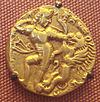 |
415–455 | He seems to have maintained control of his inherited territory, which extended from Gujarat in the west to Bengal region in the east. |
| Skanda-Gupta |  |
455–467 | It is stated that he restored the fallen fortunes of the Gupta family, which has led to suggestions that during his predecessor's last years, the Empire may have suffered reverses, possibly against the Pushyamitras or the Hunas. He is generally considered the last of the great Gupta Emperors. |
| Puru-Gupta | 467–472 | ||
| Kumara-Gupta II Kramaditya |  |
472–479 | |
| Buddha-Gupta |  |
479–496 | He had close ties with the rulers of Kannauj and together they sought to run the Alchon Huns (Hunas) out of the fertile plains of Northern India. |
| Narasimha-Gupta Baladitya |  |
496–530 | |
| Kumara-Gupta III | 530–540 | ||
| Vishnu-Gupta Candraditya |  |
540–550 | |
| Bhanu-Gupta | ? | A lesser-known king with uncertain position in the list. | |
Later Gupta dynasty (c. 490 – 750 CE)
The known Later Gupta rulers included:[16][17][18]
- Nrpa Shri Krishna-gupta
(490–505 CE)
- Deva Shri Harsha-gupta
(505–525 CE)
- Shri Jivita-gupta I
(525–550 CE)
- Shri Kumara-gupta
(550–560 CE)
- Shri Damodara-gupta
(560–562 CE)
- Shri Mahasena-gupta,
(562–601 CE)
- Shri Madhava-gupta
(601–655 CE)
- Maharajadhiraja Aditya-sena
(655–680 CE)
- Maharajadhiraja Deva-gupta
(680–700 CE)
- Maharajadhiraja Vishnu-gupta
(700–725 CE)
- Maharajadhiraja Jivita-gupta II
(725–750 CE)
See also
References
- ^ a b Bronkhorst 2007.
- ^ Macdonell, Arthur Anthony; Keith, Arthur Berriedale (1995). Vedic Index of Names and Subjects. Motilal Banarsidass Publishe. ISBN 9788120813328.
- ^ M. Witzel. "Rigvedic history: poets, chieftains, and polities," in The Indo-Aryans of Ancient South Asia: Language, Material Culture and Ethnicity. ed. G. Erdosy (Walter de Gruyer, 1995), p. 333
- ^ Ramesh Chandra Majumdar (1977). Ancient India. Motilal Banarsidass Publ. ISBN 81-208-0436-8.
- ^ Sinha, Bindeshwari Prasad (1977). Dynastic History of Magadha, Cir. 450-1200 A.D. Abhinav Publications. p. 128.
- ^ "Lumbini Development Trust: Restoring the Lumbini Garden". Archived from the original on 6 March 2014. Retrieved 6 January 2017.
- ^ Tenzin Tharpa, Tibetan Buddhist Essentials: A Study Guide for the 21st Century: Volume 1: Introduction, Origin, and Adaptation, p.31
- ^ Sanjeev Sanyal (2016), The Ocean of Churn: How the Indian Ocean Shaped Human History, section "Ashoka, the not so great"
- ^ Ray, Reginald (1999). Buddhist Saints in India. Oxford University Press. pp. 237–240, 247–249. ISBN 978-0195134834.
- ^ Jaini, Padmanabh S. (2001). Collected papers on Buddhist Studies. Motilal Banarsidass. pp. 57–77. ISBN 978-8120817760.
- ^ Patel, Haresh (2009). Thoughts from the Cosmic Field in the Life of a Thinking Insect [A Latter-Day Saint]. Strategic Book Publishing. p. 271. ISBN 978-1-60693-846-1.
- ^ Witzel, Michael (1997). "Macrocosm, Mesocosm, and Microcosm: The Persistent Nature of 'Hindu' Beliefs and Symbolic Forms". International Journal of Hindu Studies. 1 (3): 501–539. doi:10.1007/s11407-997-0021-x. JSTOR 20106493. S2CID 144673508.
- ^ Bronkhorst 2007, pp. xi, 4.
- ^ a b Bronkhorst 2007, p. 265.
- ^ Wynne, Alexander (2011). "Review of Bronkhorst, Johannes, Greater Magadha: Studies in the Culture of Early India". H-Buddhism. Retrieved 25 August 2019.
- ^ Ronald M. Davidson 2012, p. 35.
- ^ Sailendra Nath Sen 1999, pp. 247–248.
- ^ Hans Bakker 2014, p. 83.
Sources
- Hans Bakker (2014). The World of the Skandapurāṇa. BRILL. ISBN 978-90-04-27714-4.
- Ronald M. Davidson (2012). Indian Esoteric Buddhism: A Social History of the Tantric Movement. Columbia University Press. ISBN 9780231501026.
- Sailendra Nath Sen (1999). Ancient Indian History and Civilization. New Age. ISBN 9788122411980.
- Raychaudhuri, H.C. (1972). "Political History of Ancient India". Calcutta: University of Calcutta.
{{cite journal}}: Cite journal requires|journal=(help) - Law, Bimala Churn (1926). "4. The Magadhas". Ancient Indian Tribes. Lahore: Motilal Banarsidas.
- Bronkhorst, Johannes (2007). Greater Magadha : studies in the culture of early India (PDF). Handbook of oriental studies. Section two, India. Vol. 19. Leiden Boston: Brill. ISBN 978-90-04-15719-4. ISSN 0169-9377. OCLC 608455986.
- Singh, Upinder (2016), A History of Ancient and Early Medieval India: From the Stone Age to the 12th Century, Pearson, ISBN 978-81-317-1677-9
- Use dmy dates from July 2013
- Magadha
- Ancient India
- Empires and kingdoms of India
- History of Bihar
- Iron Age cultures of South Asia
- Mahajanapadas
- Jain empires and kingdoms
- Regions of Bihar
- Kingdoms of Bihar
- 4th-century BC disestablishments in India
- Magahi language
- Ancient Indian cities
- Empires and kingdoms of Nepal
- 4th-century BC disestablishments in Nepal







